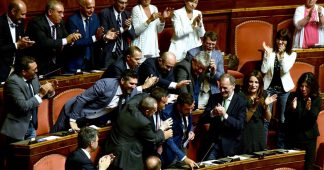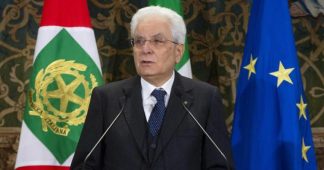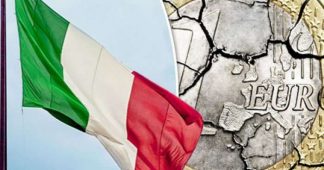To solve the political stalemate in incumbent premier Giuseppe Conte’s coalition, president Sergio Mattarella has tasked none other than former European Central Bank head Mario Draghi to form a new administration. Draghi is one of the architects of European austerity — and the person responsible for the memoranda that have devastated the Greek economy.
Draghi’s appointment — made with no reference to any kind of election or even the main parties — repeats the same old cure of “fiscal responsibility” designed to improve Italy’s “international reputation.” But it’s also something else. In the aftermath of the pandemic, it is also an attempt by business circles to lay their hands on the European Recovery Fund investment — directing it toward the business sector, rather than helping ordinary people.
Centrists for Hire
Draghi’s proposed new government – which will now need to find a majority in parliament — comes after the crisis of the so-called Conte II government. From June 2018 head of a coalition including the populist Five Star Movement (M5S) and the right-wing Lega, from September 2019 Conte instead led a coalition comprising M5S, the center-left Partito Democratico (PD), the small left-wing Liberi e Uguali, and the centrist-neoliberal Italia Viva.
Last month, with the pandemic still raging, the small Italia Viva — the political house organ of Italian financial elites, led by 2014–16 prime minister Matteo Renzi — finally brought the government to its knees. Evidently, even the moderate social measures promoted by Conte were seen as unacceptable by Italian business circles.
Created as a split from the PD, which Renzi himself led between 2013 and 2018, Italia Viva is extremely unpopular: only 3 percent of Italians support it, according to polls. Yet, it controls a handful of senators that were decisive for Conte’s majority. Renzi counts many dirty political fixers among his close friends. In a scene worthy of a spy novel, just before sparking this crisis he visited one such figure who is in jail for corruption — former senator Denis Verdini, whose daughter is the fiancée of right-wing populist Lega’s leader Matteo Salvini.
Renzi has also earned scorn for his dubious international allies. A great friend of Tony Blair, in the middle of the current crisis he flew to Saudi Arabia for a paid conference to praise the “great, great” crown prince Mohammed bin Salman, despite his implication in the killing of journalist Jamal Khashoggi, the massacre in Yemen, and Saudi support for the dictatorship in Egypt, at whose hands the young Italian labor researcher Giulio Regeni was killed in 2016, while Renzi was prime minister.
While he initially supported the creation of the Conte II government in 2019, Renzi’s splinter group acted more as an internal opposition to the government than an ally. He strongly criticized the moderate social measures Conte had implemented, starting with the “citizens’ income,” a government transfer that helps around one million Italian families in conditions of extreme poverty.
Furthermore, he often insisted that Italy had to apply for the European Stability Mechanism (ESM), providing loans for financially struggling countries. M5S strongly opposed this because of fear of the conditionalities attached to it, while also noting that no other European country intends to use these loans. After launching repeated ultimatums from his Twitter account, Renzi eventually decided to pull down Conte’s government, as he asked the two Italia Viva ministers to resign.
Some thought Renzi just wanted more ministries and power within the existing coalition. But it soon became apparent that his extortionate demands were merely a ruse to put an end to Conte’s government. Ultimately, he had three real aims. First, unseating Conte who had become far too popular for his liking, and still has the support of around half of Italians. Second, disorganizing the new center-left project that PD and M5S were working on, uniting a broad social bloc comprising precarious workers (M5S) and public employees and pensioners (PD).
But third, the arch-neoliberal Renzi sought to create political chaos in which the instinctive response of the Italian establishment, starting with President Sergio Mattarella, would be to resort to the usual cure for moments of crisis: a technocratic government implementing the “reforms” demanded by EU and business potentates. With Draghi’s nomination, all of these objectives have now been achieved.
Technocrats in Charge
So-called “technical” governments are an obvious affront to democracy. Indeed, this is but the most extreme manifestation of the post-democratic tendency in capitalist democracies, discussed by political scientists such as Colin Crouch.
It’s one thing to have a government that depends on the work of supposedly nonpolitical experts to staff its ministries and agencies, and something else to have a government actually led by a nonelected technocrat. Italy is one of the very few countries in the West where such a thing is not only considered acceptable but has even become something of a tradition.
Political scientists Duncan McDonnell and Marco Valbruzzi have counted a total of twenty-four technocrat-led governments in Europe between World War II and 2013. Greece and Romania top the list at five each; a Draghi government is expected to become Italy’s fourth. What’s more, all the technocrat-led governments in Italy have happened in a short period of time, since the fall of the so-called First Republic in the early 1990s — and they have invariably presided over harsh, budget-cutting economic policies.
The first technocrat-led government was formed by Carlo Azeglio Ciampi in 1993. As governor of Italy’s central bank during the 1980s, Ciampi had contributed to demolishing Keynesian consensus, advocating the independence of the central bank and balanced budgets. Once prime minister, he promoted the first mass round of privatization of state assets, putting an end to state participation in major banks, the electricity company Enel, and petrol company Agip, and practiced an “incomes policy” putting downward pressure on wages. All this was designed to prove Italy’s credentials to enter the process leading to the creation of the euro.
Just a few years later, it was the turn of Lamberto Dini, prime minister between 1995 and 1996. Like Ciampi and Draghi, he also hailed from the Italian central bank of which he was the director general. Dini became prime minister after the fall of the first executive led by Silvio Berlusconi and proceeded on the path of privatization and “fiscal responsibility” inaugurated by Ciampi, for example, by forcing through a major pension reform.
The fall of Berlusconi’s last cabinet in fall 2011 saw another technocrat, Mario Monti, becoming premier. The Milan media magnate was hurried out of government amid financial speculation against Italian bonds, and the scandal of his sex encounters with an underage prostitute. Disturbingly, his exit from power came after a fierce letter authored by Draghi — already ECB head at the time — and a joint press conference by German chancellor Angela Merkel, and French president Nicolas Sarkozy who clearly expressed their wish that Berlusconi be removed.
For all of Berlusconi’s corruption and antics, Italians soon learned that things could get even worse. In Berlusconi’s stead, the then president Giorgio Napolitano installed Monti, an economics professor hailing from Milan’s elite Bocconi University — the Italian equivalent of the Chicago School in its fanatical embrace of neoliberal policies. Monti had recently served as a European commissioner from 1995 to 2004, responsible first for Internal Market, Services, Customs, and Taxation, and then for Competition. He was called in — as invariably happens with the rhetoric ushering in technocratic governments — to “rescue Italy.”
Monti behaved in government very much as if he was still an EU commissioner, or a colonial governor sent to sort out an unruly region of the empire. He administered the structural adjustment “cure” recommended by Brussels in full, thus severely damaging an economy that had long been in stagnation due to restrictive EU budget rules. He introduced a package insultingly named “Salva Italia” (Save Italy), which cut public spending to the bone. This meant cuts to public pensions, but it particularly affected the health sector, with consequences that have become all too apparent amid the COVID-19 crisis.
Monti’s prime objective, as he declared to CNN, was “suppressing domestic demand” by lowering wages in order to improve “international competitiveness.” Unsurprisingly, Italians were not too happy. By the end of the legislature in 2013 his government had the approval of only 25 percent of Italians and his centrist party Scelta Civica only received 8 percent of the vote in the elections that year.
A Former Goldman Sachs Employee for PM
Given the precedents, a Draghi government is a worrying prospect. Draghi may perhaps seem a less staunch neoliberal compared to Monti. His tenure at the ECB between 2011 and 2019 was applauded by the liberal press for having saved the eurozone, with his famous promise to do “whatever it takes,” putting a halt to financial speculation on sovereign bonds and earning him the nickname “Supermario.”
But it should not be overlooked that Draghi was one of the architects of austerity in the aftermath of the 2008 crisis. He was one of the main people behind the implementation of contractionary policies that strangled many European economies, especially those in the South. Furthermore, the quantitative easing programs that took place under his watch, far from pumping resources into the real economy, only inflated assets. Ultimately the greatest winner was the German economy, profiting from currency devaluation.
Some recent declarations may lead some to think that Draghi has learned the lessons of the failure of austerity. In a famous Financial Times op-ed in March 2020, the former ECB head declared that it should be accepted that higher public debts will be with us for the foreseeable future. In August, speaking at the annual meeting of right-wing Catholic group Comunione e Liberazione, he argued that states should create “good debt,” namely investment in productive infrastructure.
This change in rhetoric parallels the positions of other financial leaders such as Kristalina Georgieva, the current International Monetary Fund chief who has asked governments to “spend as much as you can.” But it would be wrong to take this as a commitment to anything but measures to save a failing capitalism from disaster.
As a former Goldman Sachs employee, Draghi will have the responsibility of managing the two hundred billion euros made available by the European Union through the recovery fund. It is likely that a considerable amount of these funds will now be diverted toward big business represented by Confindustria, the Italian employers’ federation. Unsurprisingly, Confindustria is Draghi’s biggest cheerleader.
Draghi will probably not have the time nor political strength to repeal some social policies such as the citizens’ income policy (though he may restrict its criteria) and enforce new cuts on public spending. But he will undoubtedly attempt to put the Italian economy back on the path of “fiscal responsibility” that some European institutions, including the European Central Bank, think it has strayed from during the coronavirus crisis.
In particular a Draghi government will surely mean the nonrenewal of the temporary layoffs ban, introduced in March 2020 and due to end in two months. This was one of the most socially progressive measures implemented by Conte’s government during the pandemic, forcing private companies to shoulder part of the economic costs of the crisis. But Confindustria has repeatedly asked to get back the fundamental privilege of the entrepreneur: the right to fire workers. Draghi is likely to fulfill its wish — sending hundreds of thousands of Italians into unemployment and poverty.
The key question now is how Italian political forces and ordinary citizens will react to this outrageous departure from democratic principles and the renewed attempt to subordinate Italian politics to the fiscal responsibility demanded by Brussels. It is unlikely that Democrats will resist the calls for “responsibility” made by Mattarella, who himself hails from this party. A parliamentary majority could be found with the votes of PD, Lega, Berlusconi’s Forza Italia, plus the usual turncoats that famously abound in the Italian parliament.
M5S is the only formation that may say no — though even this is hardly assured. Doing so could help it regain some of its street credentials, lost after three years in government as part of two different coalitions. Italians are angry at Renzi and the political chaos he has ushered in, and a number of groups have already taken to the street during the pandemic to voice their concerns. If Draghi is not careful, he may have to deal not only with a health and economic emergency, but also with a public order one.
In this dismal situation, the only hope is that the citizenry that has mostly remained quiescent during this crisis eventually wakes up. If this does not happen, a technocratic government could soon lead to a reactionary government led by Salvini’s Lega and Giorgia Meloni’s post-fascist Brothers of Italy, when the next elections come.
All this, thanks to corrupt centrist politicians — and the Italian establishment’s proclivity, in times of crisis, to call in technocrats, rather than call elections and let the people decide what kind of economic policy they prefer
Published at www.jacobinmag.com











